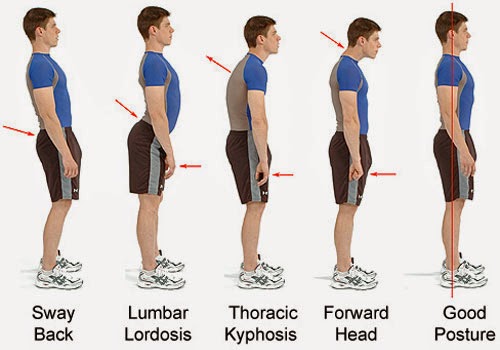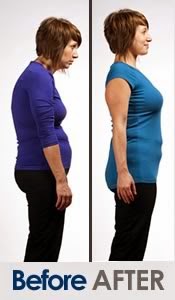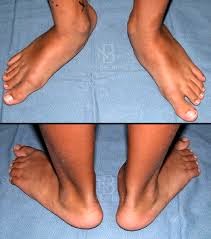
Straighten up that back soldier! No seriously, if you are like the majority of the population, chances are you are suffering from symptoms correlated with bad posture. Catching a glimpse of myself in the mirror, it’s easy to see that I have forward neck/head posture. This is normally caused by a variation of weak neck muscles, seated job positions, incorrect sleeping positions, and prolonged computer or TV use. But other than the un-esthetic aspect of bad posture, there’s really not much to worry about right? Wrong.
Over time, poor posture takes a serious toll on your spine, shoulders, hips, and knees. In fact, it can cause a cascade of structural flaws that lead to back and joint pain, reduced flexibility, and compromised muscles, all of which limit your ability to burn fat or build strength.
Worst of all, bad posture can cause nerve constriction. As the spine changes in shape, the resulting movements or subluxations can put pressure on the surrounding spinal nerves. Because the nerves that connect to the spine come from all over the body, these pinched nerves can not only cause neck and back pain but may also cause pain in other unrelated areas of the body.
The following article will explore 6 common bad posture positions that many of us are making and will provide solutions to help correct these postures.
Rounded Shoulders

The problem: Weakness in the middle and lower parts of your trapezius (the large muscle that spans your shoulders and back).
The fix: Lie facedown on the floor, with each arm at a 90-degree angle in the high-five position. Without changing your elbow angle, raise both arms by pulling your shoulders back and squeezing your shoulder blades together. Hold for five seconds. That’s one rep; do two or three sets of 12 reps daily.
Forward Neck/Head

The problem: Stiff muscles in the back of your neck.
The fix: Moving only your head, drop your chin down and in toward your sternum while stretching the back of your neck. Hold for a count of five; do this 10 times a day.
Anterior Pelvic Tilt

The problem =: Tight hip flexors.
The fix: Kneel on your left knee, with your right foot on the floor in front of you, knee bent. Press forward until you feel the stretch in your left hip. Tighten your butt muscles on your left side until you feel the front of your hip stretching comfortably. Reach upward with your left arm and stretch to the right side. Hold for a count of 30 seconds. That’s one repetition; do three on each side.
Elevated Shoulder

The problem: The muscle under your chest (running from your ribs to your shoulder blades) is weak.
The fix: Sit upright in a chair with your hands next to your hips, palms down on the seat, arms straight. Without moving your arms, push down on the chair until your hips lift up off the seat and your torso rises. Hold for five seconds. That’s one repetition; do two or three sets of 12 reps daily.
Pigeon Toes

The problem: Weak glutes (butt muscles).
The fix: Lie on one side with your knees bent 90 degrees and your heels together. Keeping your hips still, raise your top knee upward, separating your knees like a clamshell. Pause for five seconds, then lower your knee to the starting position. That’s one rep. Perform two or three sets of 12 reps on each side daily.
Duck Feet

The problem: Your oblique muscles and hip flexors are weak.
The fix: Get into a pushup position with your feet resting on a stability ball. Without rounding your lower back, tuck your knees under your torso, using your feet to roll the ball toward your body, then back to the starting position. That’s one rep. Do two or three sets of six to 12 reps daily.
Assess Your Posture Right Now!
Wear something form-fitting and take two full-body photos—one from the front, one from the side. Relax your muscles and stand as tall as you can, feet hip-width apart. Then refer to the fix-it plan (below left) to diagnose your posture problems.1 / Look at your ear. If it’s in front of the midpoint of your shoulder, your head is too far forward.
2 / Can you see your shoulder blade? That means your back is too rounded.
3 / If your hips tilt forward and you have a belly pooch (even if you don’t have an ounce of fat on your body) and your lower spine is arched significantly, this means you have an anterior pelvic tilt.
4 / Look at your shoulders. One shouldn’t appear higher than the other.
5 / Check out your kneecaps. Do they point inward, causing your knees to touch when your legs are straightened?
6 / See if you’re duck-footed. Your toes will point outward more than 10 degrees.
There you have it! Correcting poor posture while you are young will help prevent further more severe complications in the future. Try these corrective procedures and let us know how they work for you in the comment section below :D
Sources: Collective Evolution, Womens Health Mag, Live Strong
Related:
- Why Dehydration Is Making You Fat And Sick
- Napping can Dramatically Increase Learning, Memory, Awareness, and More
- Alternative Sleep Cycles: 7-10 Hours Are Not Needed
- 8 Sleeping Positions & Their Effects On Health
- 5 Food-Medicines That Could Quite Possibly Save Your Life
- 11 Ways to Naturally Boost Your Metabolism for Weight Loss
- 15 Plants & Herbs That Can Boost Lung Health, Heal Respiratory Infections & Repair Pulmonary Damage
- Science Confirms Turmeric As Effective As 14 Drugs
- The Man Who Defied Odds, Turned Down Chemotherapy and Drugs and Outlived All His Doctors
- How to Clean Your Liver with 5 Natural Liver-Cleansing Tips
- How To Clean Your Arteries With One Simple Fruit
- How to Heal Cavities Naturally












Pure Clear Hemp Oil Strengths: 250mg, 500mg, 1,000mg, and 3,000mg
ReplyDeleteGreat Info shared
ReplyDeleteBuy CPAP Machine Delhi
Thanks for sharing the info, keep up the good work going.... I really enjoyed exploring your site. good resource... Health Topics
ReplyDelete